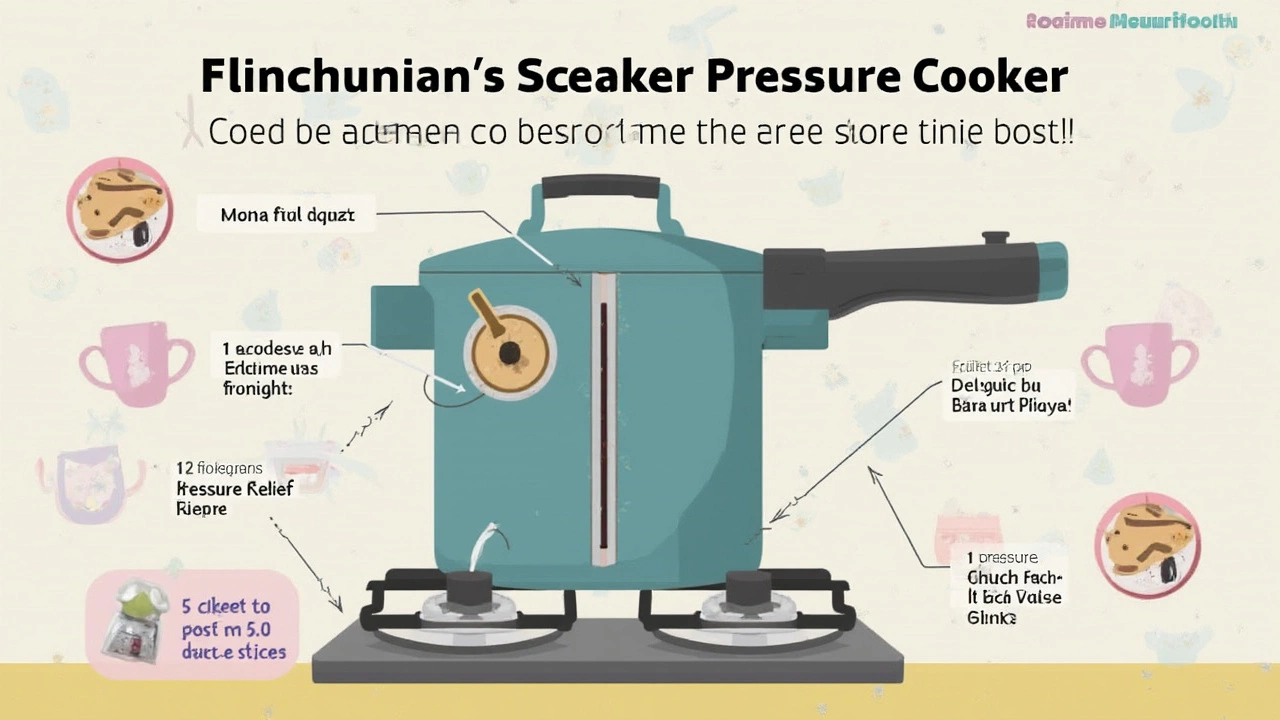Cookers can be a real asset in the kitchen, but when something goes wrong, it can turn into a disaster waiting to happen. One thing no one wants to deal with is a cooker explosion. It sounds dramatic, but knowing the common issues can make all the difference.
Let's talk pressure. The heart of many cookers is their ability to trap steam; it's what helps food cook faster. But if the steam can't escape properly, it might find another way out—fast and loud. Most problems start with blocked pressure release valves. You wouldn’t want to trap a huffing and puffing steam inside, right?
Sometimes it’s not just about steam. Those trusty seals and gaskets keep the cooker tight and secure, but wear and tear can mess things up. A damaged seal could mean your cooker isn't as sealed as it should be, letting steam leak in hazardous ways.
- Understanding Cooker Pressure
- Blocked Pressure Valves
- Faulty Seals and Gaskets
- Regular Maintenance Tips
- Safe Usage Guidelines
Understanding Cooker Pressure
Pressure cookers are brilliant for speeding up cooking times, thanks to their unique design which traps steam inside. This increases the internal pressure, allowing the temperature to rise beyond boiling point. The magic happens due to basic physics: higher pressure means higher boiling point, which cooks food faster.
When you're using a cooker, it’s crucial to understand how this pressure is managed. Typically, pressure cookers come with a pressure relief valve that regulates the build-up. If everything’s working fine, the excess pressure is safely released from this valve.
Common Pressure Problems
Now, imagine what could happen if that valve is stuck or blocked. Yep, the pressure has nowhere to go and things could get messy. Blocked valves usually occur due to food debris or grease. Cleaning them regularly keeps the system working as it should.
Just like any gadget, wear and tear can creep in on a pressure cooker too. The rubber ring or gasket, which forms the seal between the lid and the pot, can get worn out or misplaced. This might compromise the pressure balance inside.
Safeguards to Rely On
Luckily, most modern pressure cookers are equipped with multiple safety features, including backup pressure relief valves and even locking mechanisms that prevent the lid from being accidentally opened when the pot is still pressurized. These features greatly reduce the risk of cooker explosion, but keeping an eye on their condition is always a good idea.
| Pressure Cooker Features | Function |
|---|---|
| Primary Pressure Valve | Regulates pressure build-up |
| Secondary Relief Valve | Provides additional safety release |
| Locking Mechanism | Prevents lid opening under pressure |
By understanding these elements, you can keep your trusty kitchen appliance working safely and efficiently. Regular checks and maintenance save you from potential accidents and preserve your cooker for many meals to come.
Blocked Pressure Valves
One of the main culprits behind a cooker explosion is a blocked pressure valve. These tiny components might not seem like much, but they're the gatekeepers of safety in your kitchen. So what happens when they get blocked? Well, if the pressure can't escape, it builds up inside the cooker, seeking any weak point to burst out. This is why keeping your valve clean is super important.
Wondering how these valves get blocked in the first place? Often, it's stuff like food residues and grease that sneak their way into the valve over time, sealing it shut without you even realizing it. Once it's clogged, trouble’s just around the corner.
How to Keep Valves Clean
It's easier than you think to avoid this cooker's worst-case scenario. Simply checking and cleaning them regularly can prevent a pressure cooker repair headache.
- After each use, take out the valve (if possible) and soak it in warm, soapy water to remove any stubborn food bits.
- A small brush or even a toothpick can help you dig out any lodged particles. Just be gentle with it!
- Ensure it's dry before putting it back. Moisture can lead to more blockage.
Spotting a Problem Before it Happens
Listen to your cooker. If it's making strange hissing noises or not releasing steam like usual, it could be a sign that you need to check the valve. Consistent steam is a good thing; it means everything's working as it should.
Remember, patience and a bit of routine maintenance can keep your cooker and your kitchen safe. A little attention to these details goes a long way in preventing kitchen disasters.

Faulty Seals and Gaskets
Your cooker’s seals and gaskets are like its trusty guards, keeping all the pressure where it should be. But over time, they wear out, become brittle, or might even crack. It’s like having a worn-out sneaker—still usable, but not really reliable when it comes to keeping your foot dry in rain.
So what causes these seals and gaskets to fail? It's mostly normal wear and tear, but cooking acidic foods frequently or using your cooker more than average can speed up the process. When these parts fail, your cooker can’t maintain pressure as it should, which might lead to leaks and, in a worst-case scenario, a build-up of pressure causing an explosion.
How to Check Your Gaskets
- First, inspect the gasket visually. Look for any visible cracks, softness, or an overly thin appearance.
- If you notice it’s not sitting snugly in place, it might be time for a replacement.
- Bend it slightly—carefully. If it’s stiff or cracks, it’s a clear sign it's time for a new one.
Replacing Faulty Gaskets
Replacing them isn’t a huge chore but requires attention. You’ll usually find replacement gaskets in a cooker-friendly store or online. Remember to check your cooker’s model number to ensure compatibility.
Some cookers come with a shelf life for seals and gaskets. It's good practice to change them as recommended, even if they look fine. This small investment can save you from a big kitchen mess down the road.
Long-term Care
Once you’ve got a fresh set of gaskets, extend their life by avoiding extreme temperature changes. Let your cooker cool down naturally instead of trying to speed things up under cold water immediately. Think of it like you’d treat an engine after a long drive!
These don’t just help prevent a potential cooker explosion, but also make sure your food cooks evenly and efficiently, saving you both time and energy. A little care now can go a long way in keeping your kitchen safe.
Regular Maintenance Tips
Taking good care of your cooker is like taking care of a pet—it needs regular attention and a bit of love to keep it going. If you’ve ever wondered how to keep your cooker in tip-top shape, you’re in the right place.
Check and Clean the Pressure Valve
One of the main culprits for cooker explosions is a blocked pressure valve. Make it a habit to check and clean the valve after each use. Run warm water through the valve to clear any food particles or residues. It’s a quick task that can prevent a lot of trouble.
"Regular inspection and cleaning extend the lifespan of your appliances," says James Cardon, a kitchen safety expert at SafeCook.
Inspect Seals and Gaskets
The seals and gaskets are like the air-tight sealing needed for a scuba diver's suit. Check them for any signs of wear and tear. Replace the seals if they appear cracked or rigid. A minor investment in seals can save you from major headaches down the line.
General Cleaning and Care
- After use, unplug your cooker and allow it to cool before cleaning.
- Use a soft cloth and mild detergent to clean the outer parts.
- For the inner pot, warm water and soap usually do the trick.
Know When It's Time to Replace
Check the manufacturer’s guidelines about lifespan and replacement times. If your cooker is older than the suggested duration, it might be safer to invest in a new model.
Keep an Eye on the Little Things
Screws, power cords, and handles might seem minor but can affect the safety of your cooker. Periodically, make sure everything is tight and intact.
| Maintenance Task | Frequency |
|---|---|
| Clean Pressure Valve | After Each Use |
| Inspect Seals and Gaskets | Monthly |
| Full Cooker Clean | Weekly |
| Check Screws and Cords | Quarterly |
By following these easy steps, your cooker will be safer, last longer, and work like a charm while you whip up those meals.

Safe Usage Guidelines
Using your cooker safely is all about following straightforward steps and being aware of its components. Let's make sure your kitchen stays safe and your meals keep cooking properly.
Read the Manual
It might be tempting to skip this, but your cooker's manual is your best friend. Each model has its quirks, and the manual gives you tips straight from the manufacturer on avoiding a cooker explosion.
Inspect Before Use
Before each use, do a quick check. Look for any visible damage on the pressure relief valve, gaskets, and seals. If anything looks worn out or cracked, consider replacements.
Avoid Overfilling
Don’t overfill the cooker. Most manuals indicate a maximum fill line for a reason. Too much food or liquid inside can block pathways and cause pressure to rise too high.
- Fill no more than two-thirds with solids.
- For liquids, keep it below the half mark.
Keep It Clean
After each meal, clean your cooker thoroughly. Especially pay attention to the valve and the seal. Any food residue can lead to blockages, which could cause safety issues.
| Component | Recommended Inspection Frequency |
|---|---|
| Pressure Valve | Before each use |
| Gaskets and Seals | Every 6 months |
Handle with Care
Don’t rush to open the lid after cooking. Let the pressure release naturally unless the recipe guarantees quick pressure release won't cause spills. Always move the cooker using its handles, even when it's not hot.
Follow these simple steps, and you’re not just preventing accidents; you’re also prolonging the life of your pressure cooker and ensuring the safety of everyone in your home.

I am an expert in the services industry with a focus on appliance repair. My passion lies in understanding how things work and educating others in simple, engaging ways. This enthusiasm fuels my writing, where I delve into topics around appliance maintenance and troubleshooting. I aim to make these subjects clear and accessible to all readers.